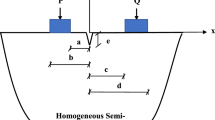Abstract
The transient elastodynamic response of the finite punch and finite crack problems in orthotropic materials is examined. Solution for the stress intensity factor history around the punch corner and crack tip is found. Laplace and Fourier transforms together with the Wiener–Hopf technique are employed to solve the equations of motion in terms of displacements. A detailed analysis is made in the simplified case when a flat rigid punch indents an elastic orthotropic half-plane, the punch approaches with a constant velocity normally to the boundary of the half-plane. An asymptotic expression for the singular stress near the punch corner is analyzed leading to an explicit expression for the dynamic stress intensity factor which is valid for the time the dilatational wave takes to travel twice the punch width. In the crack problem, a finite crack is considered in an infinite orthotropic plane. The crack faces are loaded by impact uniform pressure in mode I. An expression for the dynamic stress intensity factor is found which is valid while the dilatational wave travels the crack length twice. Results for orthotropic materials are shown to converge to known solutions for isotropic materials derived independently.
Similar content being viewed by others
REFERENCES
Achenbach, J.D. (1973). Wave Propagation in Elastic Solid, North-Holland Publishing Co, Amsterdam.
Brock, L.M. (1983). Dynamic analysis of dislocation generation due to sudden indentation. International Journal of Engineering and Sciences 21, 1437–1442.
Brock, L.M. (1996). Thermal and slip mechanism effect in rapid indentation by a flat punch. Acta Mechanica 114, 185–201.
Chen, E.P. and Sih, G.C. (1977). Transient response of cracks to impact loads. In: Elastodynamic Crack Problems(edited by Sih, G.), Noordhoff International Publishing, 1–58.
Freund, L.B. (1974). The stress intensity factor due to normal impact loading on the faces of a crack. International Journal of Engineering and Sciences 12, 179–189.
Freund, L.B. (1990). Dynamic Fracture Mechanics, Cambridge University Press, New York.
Georgiadis, H.G. (1993). Shear and torsional impact of cracked viscoelastic bodies – a numerical integral equation/transform approach. International Journal of Solids and Structures 30, 1891–1906.
Georgiadis, H.G. and Brock, L.M. (1995). Dynamic indentation of an elastic half-plane by a rigid wedge: Frictional and tangential-displacement effects. International Journal of Solids and Structures 32, 3435–3450.
Georgiadis, H.G., Theocaris, P.S. and Mouskos, S.C. (1991). Plane impact of a cracked viscoelastic body. International Journal of Engineering and Sciences 29, 171–177.
Gladwell, G.M. (1980). Contact Problems in the Classical Theory of Elasticity. Sijthoff and Noordhoff, The Netherlands.
Johnson, K.L. (1987). Contact Mechanics, Cambridge University Press, New York.
Kassir, M.K. and Bandyopadhyay, K.K. (1983). Impact response of a cracked orthotropic medium. ASME, Journal of Applied Mechanics 50, 630–636.
Nayfeh, A.H. (1995). Wave Propagation in Layered Anisotropic Media with Applications to Composites, North-Holland Publishing Company, Amsterdam.
Noble, B. (1958). Methods Based on the Wiener–Hopf Technique, Pergamon, New York.
Norris, A.N. and Achenbach, J.D. (1984). Elastic wave diffraction by a semi-infinite crack in a transversely isotropic material. Quarterly Journal of Mechanics and Applied Mathematics 37, 565–580.
Poruchikov, V.B. (1993). Methods of the Classical Theory of Elastodynamics. Springer-Verlag, New York.
Roessig, K. and Mason, J. (1998). Dynamic stress intensity factors in the dynamic punch test. Engineering of Fracture Mechanics 60, 421–435.
Rubio-Gonzalez, C. (1999). Dynamic Fracture Initiation in Composite Materials, Ph.D. thesis, University of Notre Dame.
Rubio-Gonzalez, C. and Mason, J. (2000a). Mixed mode dynamic stress intensity factor due to applied point loads. Computers and Structures 76, 237–245.
Rubio-Gonzalez, C. and Mason, J. (2000b). Dynamic stress intensity factors at the tip of a uniformly loaded semi-infinite crack in an orthotropic material. Journal of Mechanics of Physics and Solids 48, 899–925.
Rubio-Gonzalez, C. and Mason, J. (2000c). Dynamic stress intensity factor due to concentrated normal loads on semi-infinite cracks in orthotropic materials. Journal of Composite Materials 34, 649–669.
Rubio-Gonzalez, C. and Mason, J. (2001). Experimental investigation of the dynamic punch test in isotropic and composite materials. Experimental Mechanics 41, 129–139.
Thau, S.A. and Lu, T.H. (1971). Transient stress intensity factors for a finite crack in an elastic solid caused by a dilatational wave. International Journal of Solids and Structures 7, 731–750.
Ting, T.C. (1996). Anisotropic Elasticity. Oxford University Press, New York.
Willis, J.R. (1973). Self-similar problems in elastodynamics. Phil. Trans. Royal Society London 274, 435–491.
Author information
Authors and Affiliations
Rights and permissions
About this article
Cite this article
Rubio-Gonzalez, C. Elastodynamic analysis of the Finite punch and finite crack problems in orthotropic materials. International Journal of Fracture 112, 355–378 (2001). https://doi.org/10.1023/A:1013551222324
Issue Date:
DOI: https://doi.org/10.1023/A:1013551222324




